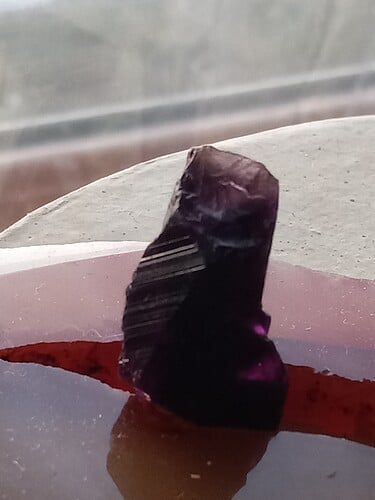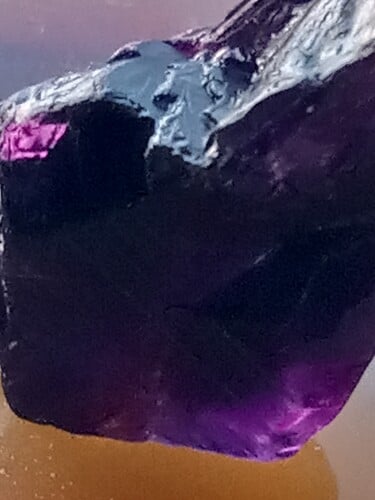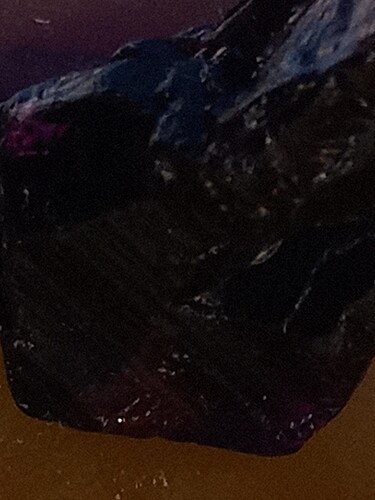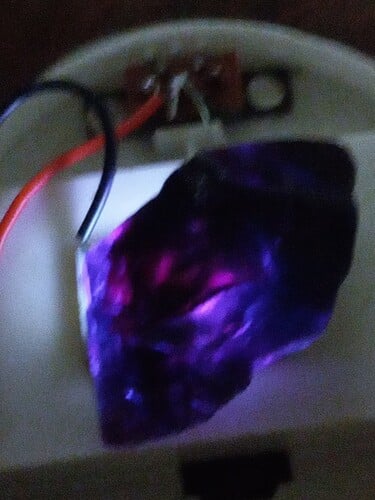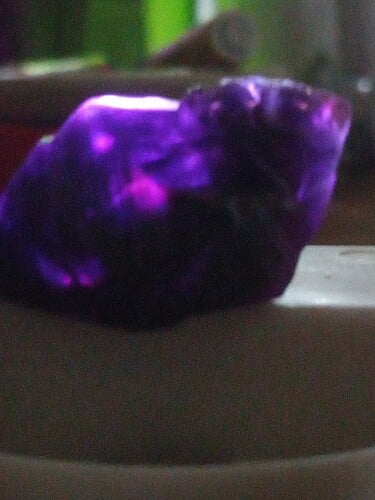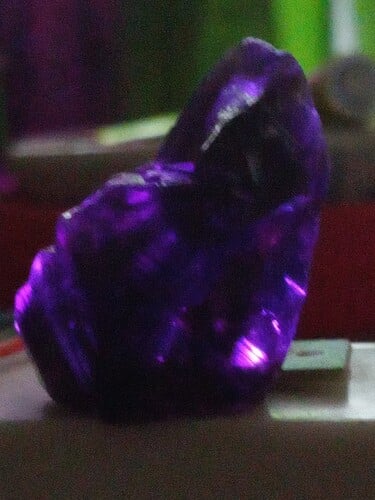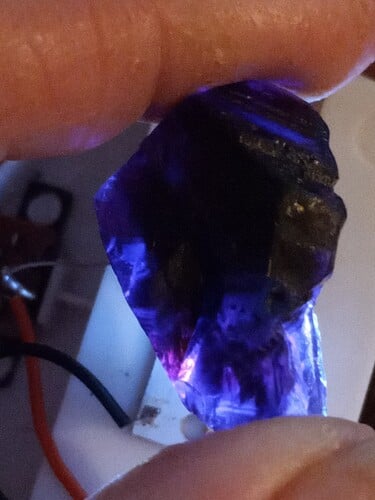This gemstone is incredible!
I keep coming up with Tanzanite as a result from LOTS of searching.
It’s blue, purple, and reddish brown… Trichromatic? The blues and purple are the most vivid colors I’ve ever seen.
i’m not the only one that just seems amethyst right?
Ive got to get a better pic. Ive got tons of amethyst, its nothing like this stone. The feel, luster, color.
I wish I had the funds to be able to buy equipment to help identify my gems and minerals and rocks. All I’ve got to go on is tons of Google research. These photos are from today, no filters, just with a small LED to show the vibrancy.
Could it be Alexandrite?
Looks like amethyst. Take it to a gemologist who will run an RI on it to make the determination. Natural amethyst is dichroic in reddish violet and bluish violet, but when heated, turns yellow-orange, yellow-brown, or dark brownish and may resemble citrine, but loses its dichroism, unlike genuine citrine.
it looks like Amethyst to me. I’ve got Amethyst from different mines, Bolivia, Morocco, Zambia and Russia and all have different colorations… Some are deep purple blue, some have purple, blue with red flashes, and others are purplish red with red needles running through them. I would look for the different mines and see what colors they produce.
A tanzanite would show distinct colors on at least two, maybe three axes, whereas what you are showing is different shades on the same axis in transmitted light. Get a $20 scale that reads to 0.01gm and do an SG. Quartz is 2.65 and tanzanite is 3.35, so you should be able to rule one or the other out even if you are off a little.
I would also recommend a Specific Gravity test to, at the very least, give you a better idea of the origins of your beautiful specimen. It is a very simple diagnostic, which will put you in the ball park. I suggest using IGS Specific Gravity chart for closing in on the exact nature of your stone. I would, at least 80% of the time, rely on IGS’s “formula” to determine the exact origin of your find. If you should find extraterrestrial elements inclusive to your stone, you should not be surprised!
Cheers!
Steve
It sure looks like amethyst.
Maybe bluish purple color changing sapphire? It really is beautiful.
I would first want to know where you purchased it from. There are a lot of fakes out there. If you put it in alcohol and you see some purple coloring of the alcohol after awhile than it is dyed and most likely dyed quartz.
I’ve never bought a stone in my life. I’ve never been to Tanzania or Alexander either. I don’t believe anyone has ever bought me stones except tumbler and polished one’s. So, after those clues, I can say that I am originally from Ithaca NY,(upstate.). I currently reside in the 10 square miles surrounded by reality, and will likely be here for the duration of my trip around the sun in these sets of peepers. That being said, I have lived up and down the east coast. I can say with certainty that the gulf Coat of Florida is not the best place for rock collection. Sea glass, fossils and ciraks; yes
I say its Alexandrite, if you look at the second picture coming down from the top of this post, you can almost see the exact growth pattern of Alexandrite
Hello Ms Brandy … If you get to Fabulous Las Vegas you could stop by my lab and I will run the SG on it for you. Also, I could place a small facet on it and take an accurate RI as well. Then you can post the pictures on here with the results. In the alternative, use a US Postal Service small flat rate box and ship it to me. I’ll run the tests and ship it back. You can contact me at thediamondgrader@yahoo.com You can see my lab set up at www.diamondgrader.com Michael ![]()
Most all tanzanite is treated.
you need some equipment.some rough is easy to determine what it is but to be exact takes knowledge and study along with the proper tools or the trade.But it does appear to look like Amethyst.
Take it out in the sunlight and take some shots of it at different angles. It may show off a bit better. I can see why everyone says amethyst.
Look forward for some better colors. Alexandrite will change colors under UV and incandescent lights. Sun light and candlelight or the good old fashioned lightbulbs.
Otter.
I have multiple Tanzanite and Amethyst stones, and beings pictures is all I have to go from, even with the new ones posted, I still have to go with Amethyst. While you can call a Ruby a Ruby, they differ greatly in price and quality depending on where they’re from and the same goes for Amethyst. .
My vote would be on a Blue Sapphire, rather than Amethyst. But, one can achieve a better opinion with a Specific Gravity test.
An SG is very simple, and something you can do yourself with a gram scale, a bowl of water, a strip of cheese cloth, a simple calculator, and the IGS Specific Gravity for Gems.
- Take the dry weight of your specimen. Log the gram of the specimen.
- Suspend the specimen in the bowl of water using the cheese cloth, making certain that you do not touch the bottom or sides of the bowl. (The cheese cloth has very little influence, as it does not reflect an SG.
- Log the wet weight of your specimen.
- Divide the weight weight into the dry weight.
- The result is the Specific Gravity of your specimen.
- Go to the IGS Specific Gravity for Gems.
- Now you will be in the ballpark!
- Most minerals listed by IGS have adjoining photos & information on nearly all known minerals. You will need to follow these links to gain a more complete picture of your specimen.
- I would say, that IGS has the most complete library on gems & minerals, but to follow through, you may want to explore Mindat, org. for further research.
I do hope this helps, as you really don’t need to go to Las Vegas, unless you have extra Rubies to burn!
Cheers;
Steve


